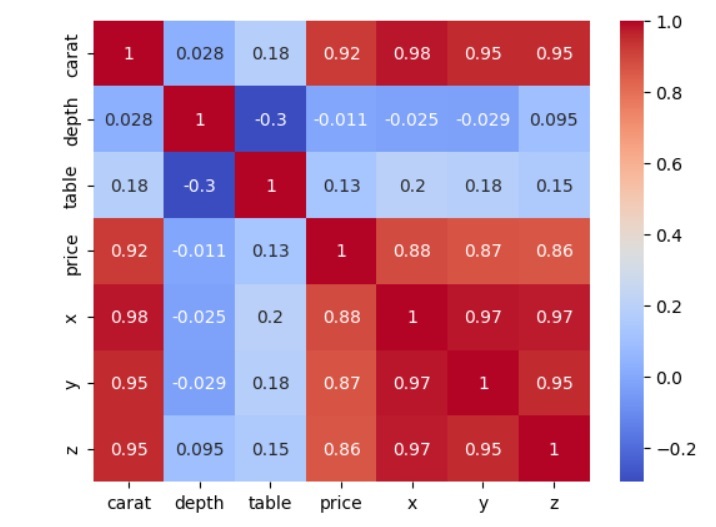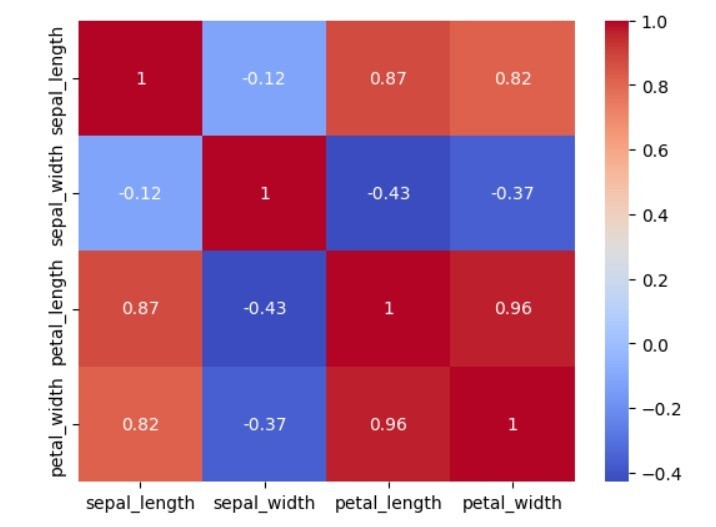如何在Python中创建seaborn相关热图?
在数据集中,两个变量对之间的相关性的强度和方向通过相关性热图进行图形化展示,该图展示了相关矩阵。这是一种在大规模数据集中寻找模式和连接的有效技术。
Python数据可视化工具Seaborn提供了简单的工具来生成统计可视化图形。用户可以通过其创建相关热图的功能快速查看数据集的相关矩阵。
我们必须导入数据集,计算变量的相关矩阵,然后使用 Seaborn 热图函数生成热图来构建相关热图。热图显示一个矩阵,其颜色表示变量之间的相关程度。此外,用户还可以在热图上显示相关系数。
Seaborn 相关热图是一种有效的可视化技术,用于检查数据集中的模式和关系,可用于查明关键变量以进行进一步调查。
使用Heatmap()函数
heatmap函数生成一个颜色编码的矩阵,用于说明数据集中两对变量之间的相关性强度。heatmap函数需要我们提供变量的相关矩阵,可以使用Pandas数据框的corr方法计算。heatmap函数提供了许多可选选项,使用户能够修改热图的视觉效果,包括颜色方案、注释、图表大小和位置。
语法
import seaborn as sns sns.heatmap(data, cmap=None, annot=None)
上述函数中的参数data是表示输入数据集的相关矩阵。用于着色热力图的颜色映射被称为cmap。
Example 1
的中文翻译为:示例1
在此示例中,我们使用 Python 创建一个 seaborn 相关热图。首先,我们导入seaborn和matplotlib库,并使用Seaborn的加载数据集函数加载iris数据集。该数据集包含 SepalLength、SepalWidth、PetalLength 和 PetalWidth 变量。鸢尾花数据集包括鸢尾花的萼片长度、萼片宽度、花瓣长度和花瓣宽度的测量值。这是信息的示例 -
| 序号 | sepal_length | sepal_width | 花瓣长度 | 花瓣宽度 | 物种 | |
|---|---|---|---|---|---|---|
| 0 | 5.1 | 3.5 | 的中文翻译为:3.5 | 1.4 | 0.2 | 丝滑 |
| 1 | 4.9 | 3.0 | 1.4 | 0.2 | 丝滑 | |
| 2 | 4.7 | 3.2 | 1.3 | 0.2 | 丝滑 | |
| 3 | 4.6 | 的翻译为:4.6 | 3.1 | 1.5 | 0.2 | 丝滑 |
| 4 | 5.0 | 翻译成中文为:5.0 | 3.6 | 1.4 | 0.2 | 丝滑 |
用户可以使用Seaborn的load dataset方法将鸢尾花数据集加载到Pandas DataFrame中。然后使用Pandas数据帧的corr方法计算变量的相关矩阵,并保存在一个名为corr_matrix的变量中。我们使用Seaborn的heatmap方法生成热力图。我们将相关矩阵corr_matrix传递给函数,并将cmap参数设置为"coolwarm"以使用不同的颜色表示正负相关。最后,我们使用matplotlib的pyplot模块的show方法显示热力图。
# Required libraries
import seaborn as sns
import matplotlib.pyplot as plt
# Load the iris dataset into a Pandas dataframe
iris_data = sns.load_dataset('iris')
# Creating the correlation matrix of the iris dataset
iris_corr_matrix = iris_data.corr()
print(iris_corr_matrix)
# Create the heatmap using the `heatmap` function of Seaborn
sns.heatmap(iris_corr_matrix, cmap='coolwarm', annot=True)
# Display the heatmap using the `show` method of the `pyplot` module from matplotlib.
plt.show()
输出
sepal_length sepal_width petal_length petal_width sepal_length 1.000000 -0.117570 0.871754 0.817941 sepal_width -0.117570 1.000000 -0.428440 -0.366126 petal_length 0.871754 -0.428440 1.000000 0.962865 petal_width 0.817941 -0.366126 0.962865 1.000000
示例 2
在这个示例中,我们再次使用Python创建一个seaborn相关性热图。首先,我们导入seaborn和matplotlib库,并使用Seaborn的load dataset函数加载钻石数据集。钻石数据集包括钻石的成本和特征的详细信息,包括它们的克拉重量、切割、颜色和净度。这是一个信息的例子 −
| 序号 | 克拉 | cut | 的中文翻译为:cut | 颜色 | 清晰度 | depth | 的中文翻译为:深度 | 表 | 价格 | x | y | z | |
|---|---|---|---|---|---|---|---|---|---|---|---|---|---|
| 0 | 0.23 | Ideal | 的翻译为:Ideal | E | SI2 | 61.5 | 55.0 | 翻译成中文为:55.0 | 326 | 3.95 | 的中文翻译为:3.95 | 3.98 | 2.43 |
| 1 | 0.21 | 高级版 | E | SI1 | 59.8 | 61.0 | 326 | 3.89 | 3.84 | 2.31 | |||
| 2 | 0.23 | 好 | E | VS1 | 56.9 | 65.0 | 327 | 4.05 | 4.07 | 2.31 | |||
| 3 | 0.29 | 高级版 | I | 的中文翻译为:I | VS2 | 62.4 | 的中文翻译为:62.4 | 58.0 | 334 | 4.20 | 4.23 | 2.63 | |
| 4 | 0.31 | 好 | J | SI2 | 63.3 | 58.0 | 335 | 4.34 | 4.35 | 2.75 | 的中文翻译为:2.75 |
可以使用 Seaborn 的加载数据集函数将钻石数据集加载到 Pandas DataFrame 中。接下来,使用 Pandas 数据帧的 corr 方法,计算变量的相关矩阵并将其存储在名为 Diamond_corr_matrix 的变量中。为了利用不同的颜色来表示与函数的正相关和负相关,我们传递相关矩阵 corr 矩阵并将 cmap 选项设置为“coolwarm”。最后,我们使用 matplotlib 的 show 方法中的 pyplot 模块来显示热图。
# Required libraries
import seaborn as sns
import matplotlib.pyplot as plt
# Load the diamond dataset into a Pandas dataframe
diamonds_data = sns.load_dataset('diamonds')
# Compute the correlation matrix of the variables
diamonds_corr_matrix = diamonds_data.corr()
print(diamonds_corr_matrix)
# Create the heatmap using the `heatmap` function of Seaborn
sns.heatmap(diamonds_corr_matrix, cmap='coolwarm', annot=True)
# Display the heatmap using the `show` method of the `pyplot` module from matplotlib.
plt.show()
输出
carat depth table price x y z carat 1.000000 0.028224 0.181618 0.921591 0.975094 0.951722 0.953387 depth 0.028224 1.000000 -0.295779 -0.010647 -0.025289 -0.029341 0.094924 table 0.181618 -0.295779 1.000000 0.127134 0.195344 0.183760 0.150929 price 0.921591 -0.010647 0.127134 1.000000 0.884435 0.865421 0.861249 x 0.975094 -0.025289 0.195344 0.884435 1.000000 0.974701 0.970772 y 0.951722 -0.029341 0.183760 0.865421 0.974701 1.000000 0.952006 z 0.953387 0.094924 0.150929 0.861249 0.970772 0.952006 1.000000

热图是一种有益的图形表示形式,seaborn 使其变得简单易用。
以上是如何在Python中创建seaborn相关热图?的详细内容。更多信息请关注PHP中文网其他相关文章!

热AI工具

Undresser.AI Undress
人工智能驱动的应用程序,用于创建逼真的裸体照片

AI Clothes Remover
用于从照片中去除衣服的在线人工智能工具。

Undress AI Tool
免费脱衣服图片

Clothoff.io
AI脱衣机

AI Hentai Generator
免费生成ai无尽的。

热门文章

热工具

记事本++7.3.1
好用且免费的代码编辑器

SublimeText3汉化版
中文版,非常好用

禅工作室 13.0.1
功能强大的PHP集成开发环境

Dreamweaver CS6
视觉化网页开发工具

SublimeText3 Mac版
神级代码编辑软件(SublimeText3)

热门话题
 Python vs.C:申请和用例
Apr 12, 2025 am 12:01 AM
Python vs.C:申请和用例
Apr 12, 2025 am 12:01 AM
Python适合数据科学、Web开发和自动化任务,而C 适用于系统编程、游戏开发和嵌入式系统。 Python以简洁和强大的生态系统着称,C 则以高性能和底层控制能力闻名。
 如何利用Debian Apache日志提升网站性能
Apr 12, 2025 pm 11:36 PM
如何利用Debian Apache日志提升网站性能
Apr 12, 2025 pm 11:36 PM
本文将阐述如何通过分析Debian系统下的Apache日志来提升网站性能。一、日志分析基础Apache日志记录了所有HTTP请求的详细信息,包括IP地址、时间戳、请求URL、HTTP方法和响应代码等。在Debian系统中,这些日志通常位于/var/log/apache2/access.log和/var/log/apache2/error.log目录下。理解日志结构是有效分析的第一步。二、日志分析工具您可以使用多种工具分析Apache日志:命令行工具:grep、awk、sed等命令行工具可
 Python:游戏,Guis等
Apr 13, 2025 am 12:14 AM
Python:游戏,Guis等
Apr 13, 2025 am 12:14 AM
Python在游戏和GUI开发中表现出色。1)游戏开发使用Pygame,提供绘图、音频等功能,适合创建2D游戏。2)GUI开发可选择Tkinter或PyQt,Tkinter简单易用,PyQt功能丰富,适合专业开发。
 Laravel(PHP)与Python:开发环境和生态系统
Apr 12, 2025 am 12:10 AM
Laravel(PHP)与Python:开发环境和生态系统
Apr 12, 2025 am 12:10 AM
Laravel和Python在开发环境和生态系统上的对比如下:1.Laravel的开发环境简单,仅需PHP和Composer,提供了丰富的扩展包如LaravelForge,但扩展包维护可能不及时。2.Python的开发环境也简单,仅需Python和pip,生态系统庞大,涵盖多个领域,但版本和依赖管理可能复杂。
 PHP和Python:比较两种流行的编程语言
Apr 14, 2025 am 12:13 AM
PHP和Python:比较两种流行的编程语言
Apr 14, 2025 am 12:13 AM
PHP和Python各有优势,选择依据项目需求。1.PHP适合web开发,尤其快速开发和维护网站。2.Python适用于数据科学、机器学习和人工智能,语法简洁,适合初学者。
 Debian Sniffer在DDoS攻击检测中的作用
Apr 12, 2025 pm 10:42 PM
Debian Sniffer在DDoS攻击检测中的作用
Apr 12, 2025 pm 10:42 PM
本文探讨DDoS攻击检测方法,虽然未找到“DebianSniffer”的直接应用案例,但以下方法可用于DDoS攻击检测:有效的DDoS攻击检测技术:基于流量分析的检测:通过监控网络流量的异常模式,例如突发性的流量增长、特定端口的连接数激增等,来识别DDoS攻击。这可以使用多种工具实现,包括但不限于专业的网络监控系统和自定义脚本。例如,Python脚本结合pyshark和colorama库可以实时监控网络流量并发出警报。基于统计分析的检测:通过分析网络流量的统计特征,例如数据
 Nginx SSL证书更新Debian教程
Apr 13, 2025 am 07:21 AM
Nginx SSL证书更新Debian教程
Apr 13, 2025 am 07:21 AM
本文将指导您如何在Debian系统上更新NginxSSL证书。第一步:安装Certbot首先,请确保您的系统已安装certbot和python3-certbot-nginx包。若未安装,请执行以下命令:sudoapt-getupdatesudoapt-getinstallcertbotpython3-certbot-nginx第二步:获取并配置证书使用certbot命令获取Let'sEncrypt证书并配置Nginx:sudocertbot--nginx按照提示选
 debian readdir如何与其他工具集成
Apr 13, 2025 am 09:42 AM
debian readdir如何与其他工具集成
Apr 13, 2025 am 09:42 AM
Debian系统中的readdir函数是用于读取目录内容的系统调用,常用于C语言编程。本文将介绍如何将readdir与其他工具集成,以增强其功能。方法一:C语言程序与管道结合首先,编写一个C程序调用readdir函数并输出结果:#include#include#includeintmain(intargc,char*argv[]){DIR*dir;structdirent*entry;if(argc!=2){







